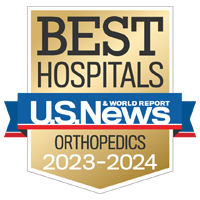Meniscus Tear

Overview
Meniscus tears are among the most common knee injuries, affecting approximately 1 million people in the U.S. each year. A healthy knee joint contains two meniscuses, C-shaped structures made of cartilage. The one on the inside of the knee is the medial meniscus; the one on the outside is the lateral meniscus. Smooth, flexible and rubbery, they provide stability and shock absorption for the precious knee cartilage lining the joint, known as the hyaline cartilage. The meniscus is essential to the health of the knee and particularly to preventing arthritis, which occurs if the hyaline cartilage is damaged or lost.
There are two types of meniscus tears: acute tears, which result from a sudden injury (trauma) to the knee, and degenerative tears, which develop over time. While both types affect the integrity of the meniscus, they're treated differently. An acute tear may happen during sports or an event in which the knee is twisted. Acute tears frequently occur in combination with other knee injuries, specifically with anterior cruciate ligament (ACL) tears. For many acute injuries, surgical treatment is considered.
A degenerative meniscus tear is more subtle, developing gradually as the hyaline cartilage and meniscus deteriorate in quality and thin with age. Often these tears go unnoticed until the tissue has degenerated a good deal, and therefore surgical repair isn't appropriate. A deteriorated meniscus may suddenly tear, however; in this case, it may be reasonable to consider surgical intervention.
Our approach to meniscus tears
At UCSF, we have world-class experts with advanced training in knee care and surgical techniques for the meniscus, as well as researchers actively working to improve therapeutic techniques. We are committed to helping patients return to the highest level of activity possible. Our team includes orthopedic surgeons, primary care sports medicine doctors, physical therapists and athletic trainers. When surgery is appropriate, we determine the best approach for each patient and use advanced minimally invasive techniques. When repairing the meniscus is no longer an option, we also have experience in meniscus transplant surgery.
Patient stories
Athlete returns to sports after meniscus tear
After an injury that left her barely able to walk, platelet-rich plasma (PRP) injections helped Heather get back to running and cycling. In May 2023, she biked a famous Alpine pass!
Awards & recognition
-

Among the top hospitals in the nation
-

One of the nation's best for orthopedic care
Signs & symptoms
The most common symptoms of a meniscus tear are:
- Knee pain and stiffness
- Swelling of the joint
- Limited range of motion in the joint
- A knee joint that locks, catches, makes an audible click or feels as though it's "giving way"
Diagnosis
Knee injuries are best diagnosed by a health care provider with sports medicine expertise. At the initial visit, the provider will do a thorough review of a patient's symptoms and medical history, plus a physical exam of the injured knee. X-rays are also commonly used to assess the overall status of the bones and check for signs of arthritis. An MRI is sometimes needed for a better look at the meniscus and to confirm the diagnosis of a meniscus tear.
Treatments
Doctors base their treatment recommendations on a variety of factors: the type of meniscus tear, the size and location of the tear, the joint's stability and the knee's overall condition, as well as the patient's age and physical activity goals. Often, particularly with degenerative tears, physical therapy, bracing, ice applications, anti-inflammatory medications and various types of injections are enough to relieve symptoms, improve function and allow a safe return to activity over time.
Surgery is generally recommended for mechanical or structural meniscus tears that could compromise the protective and stabilizing effects of the meniscus. A minimally invasive procedure called an arthroscopy allows the surgeon to see inside your knee by passing fine instruments, including a tiny camera, through small incisions on the front of your knee. If indicated, the surgeon can perform either a meniscus repair to restore its shape and function or a meniscectomy to remove the damaged section of the meniscus (when repair isn't possible).
Meniscus repair
A repair attempts to restore the natural shape of the meniscus and preserve the tissue, so it can perform its normal function of protecting the knee joint. Surgeons can suture the torn parts together with a variety of possible devices. The procedure requires an extended rehabilitation period, with use of crutches and a brace, as well as physical therapy. Not all meniscus tears will heal when repaired, and some patients need a second surgery.
Post-operative protocols depend on the type of tear, the surgical techniques utilized and other factors specific to your situation. Generally, though, patients wear a brace for two to six weeks and need crutches for part or all of that time. Physical therapy exercises are commonly prescribed to restore mobility and strength. The majority of patients return to near-normal active lifestyles after surgery and completion of physical therapy.
Meniscectomy
A meniscectomy, or meniscus debridement, is permanent removal of the damaged tissue and thus does not preserve the normal shape or volume of the meniscus. In general, a meniscectomy is associated with decent short-term symptom improvement and a relatively rapid recovery from surgery, but also possibly with an increased potential for accelerated arthritis and a higher risk of eventually needing a knee replacement. In select cases, meniscectomy does provide good longer-term results.
The post-op plan with a meniscectomy is generally shorter and simpler than for meniscus repair. Patients can put weight on their leg immediately after surgery and often just need crutches to help with balance. Physical therapy will be prescribed to restore knee motion and strength. Most patients will be fully recovered two to three months after surgery.
For these reasons, the more common procedure at this time is a meniscectomy. But under the right circumstances, meniscus repair can still be a good choice, especially since repair techniques and outcomes are continuing to improve.
Deciding between meniscus repair and removal
In many cases, the best choice is clear from your medical history, physical exam and imaging tests. However, in some cases, the repair-versus-removal decision has to be made by the surgeon during the operation, when the nature and extent of the tear can be evaluated directly. If this is your situation, your surgeon will discuss both options – including the likelihood of each – with you in advance.
Repairing the meniscus rather than removing any part of it has obvious advantages, which is why most surgeons prefer it. Meniscus tissue, however, is somewhat unpredictable in its healing due to its variable blood supply and the forces it experiences in the knee, which is why repair failure rates remain fairly high (10 percent to 30 percent, depending on the tear). Also, meniscus repair surgery takes longer and is more expensive than a meniscectomy, and the post-op regimen is considerably longer and more difficult.
Frequently asked questions
- Will I have stitches?
You'll have two or three stitches that will be removed seven to 10 days after surgery.
- When will I have a follow-up appointment?
Your doctor will examine your knee and remove the sutures about a week after surgery.
- When will I start physical therapy?
You should start physical therapy a week to 10 days after surgery.
- How long will I be on crutches?
This varies depending on your specific injury and the selected procedure. For example, if you have a meniscus repair, you may need crutches for two to six weeks. After a meniscectomy, patients usually stop using crutches sometime during the first week after surgery.
- Are cold therapy machines effective for post-op pain?
You can choose among a number of icing methods, but a simple and affordable option is placing a regular ice pack or package of frozen vegetables on your knee. Cold therapy devices are effective but expensive.
UCSF Health medical specialists have reviewed this information. It is for educational purposes only and is not intended to replace the advice of your doctor or other health care provider. We encourage you to discuss any questions or concerns you may have with your provider.










